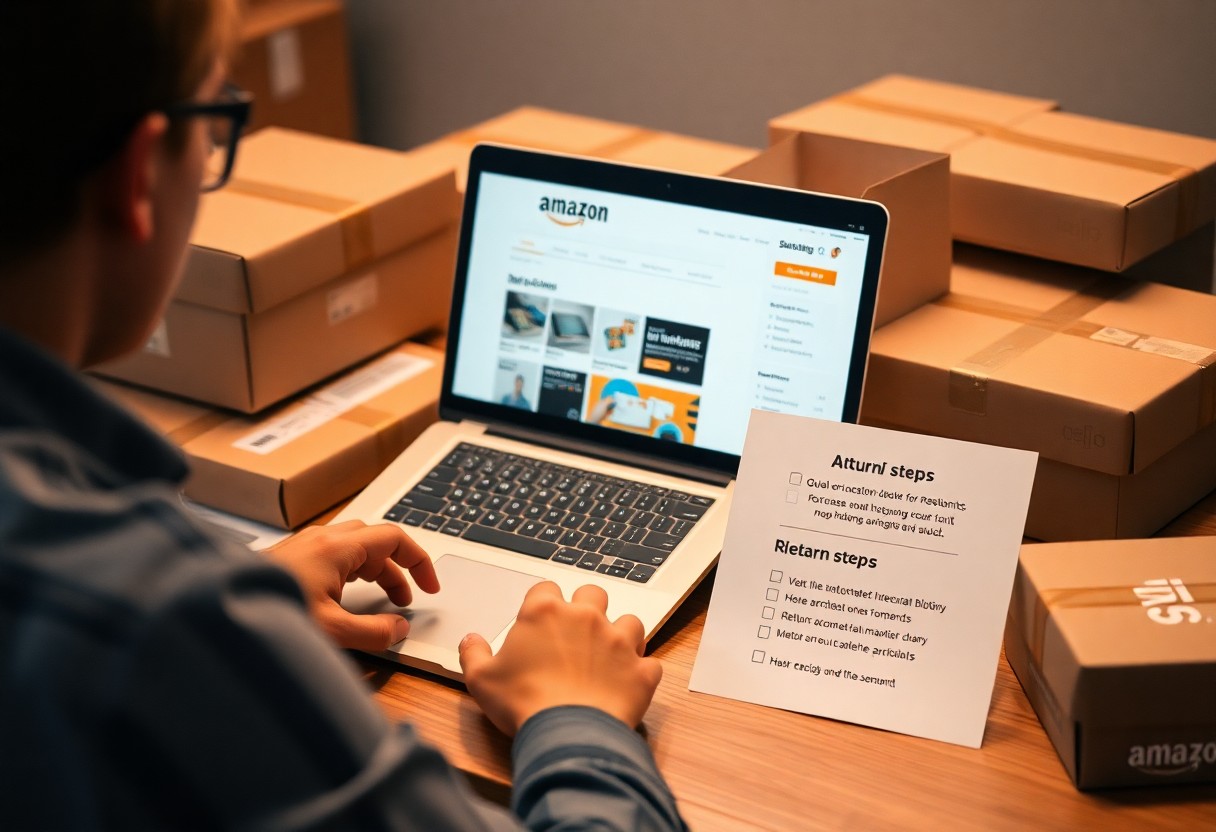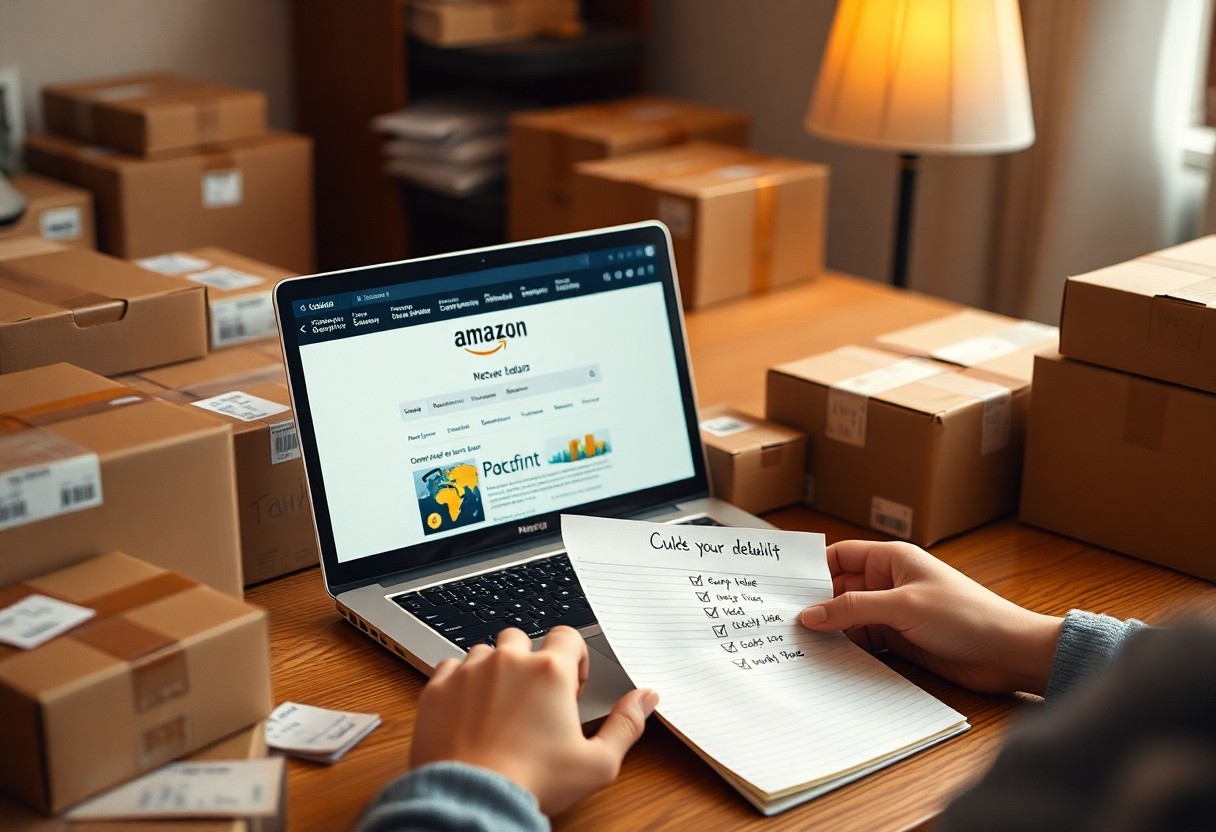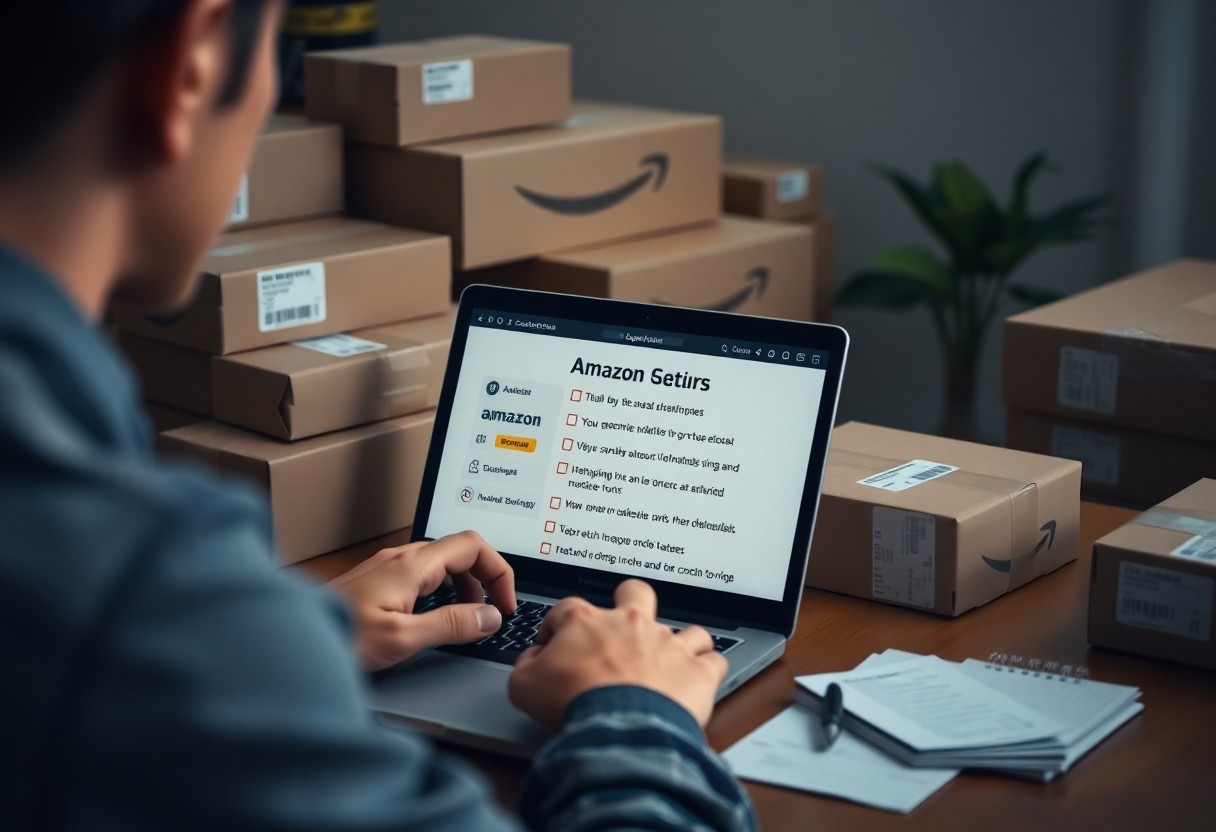Many shoppers often find themselves in need of returning items purchased from Amazon. This step-by-step guide will help you efficiently navigate the return process without any hassle. You’ll learn how to initiate a return, access your return label, and understand the timelines for refunds, ensuring that your experience is as smooth as possible. By following these quick tips, you can make the most of your Amazon shopping while avoiding any potential pitfalls along the way.
Understanding Amazon’s Return Policy
The process of shopping online presents unique conveniences and challenges, and understanding Amazon’s return policy helps you navigate it with ease. When you make a purchase on Amazon, you are covered by a return policy designed to offer you flexibility and peace of mind. Generally, items can be returned within 30 days of receipt, allowing you to evaluate your purchase and decide if it meets your expectations. Different categories of products may have distinct return timelines, so you will want to verify the specific details that apply to your purchase. Overall, Amazon’s policy aims to prioritize your satisfaction, making it easier for you to shop with confidence.
Policy considerations extend beyond just return timelines; several guidelines shape the return process. First, items must be in original condition with all accessories and packaging intact to qualify for a full refund. This means that if you decide to return a product, avoiding significant damage or depletion in quality is vital. Additionally, some items, such as digital downloads and gift cards, fall under a stricter return framework and may not be eligible for refunds at all. Make sure you familiarize yourself with these different categories to ensure a smooth return experience.
As far as receiving your refund, you should note that Amazon processes returns promptly. Depending on your payment method, refunds typically appear within days after Amazon receives your returned item. For items sold through third-party sellers, refund timelines may vary, so checking specifics for those purchases is advisable. By keeping these key elements in mind, you can confidently engage with Amazon’s return process and minimize any potential issues.
Key Elements of the Return Policy
Policy elements are fundamental to understanding your rights and responsibilities as a buyer on Amazon. Firstly, every product you purchase usually comes with a return label that simplifies the return process. This label is often provided in your account under “Your Orders” and allows you to print it out before sending the item back. It’s also important to know that quality matters: items returned in unsatisfactory condition may lead to partial refunds, so ensuring items are returned as they were received is imperative.
The policy also mentions that you can opt for an exchange rather than a return upon the selection of certain products. This option can be highly convenient if you simply want a different size or color. In many cases, Amazon covers the cost of return shipping for items that qualify, alleviating any additional financial burden on your part. Understanding these elements not only helps you manage returns but also empowers you to make informed decisions while shopping.
The inherent flexibility of Amazon’s return policy enhances your shopping experience, making it more customer-friendly. There’s no need to feel apprehensive about purchases, as the policy is designed to prioritize your convenience and satisfaction. By staying informed about these key elements, you will effectively navigate the return landscape with greater confidence.
Common Exceptions to the Policy
An important part of Amazon’s return policy involves exceptions that you should be aware of before making a purchase. While the general rule allows for returns within 30 days, certain products have different guidelines. For instance, items that fall under the category of hazardous materials or large appliances may not be eligible for return due to safety and logistical reasons. Additionally, subscriptions and services are typically non-returnable once the service period begins, which can influence how you approach purchasing such options.
Some products that have been opened or used can also face restrictions. Items like perishable goods, personalized products, and legally restricted items (e.g., certain software) are commonly excluded from the return policy. These exceptions exist to protect both your interests and those of sellers, ensuring that items are returned in a sellable state where applicable. Being aware of these exceptions can aid you in making astute choices while shopping on Amazon.
Return policies may vary based on the nature of the item, but understanding the common exceptions shields you from potential frustrations when attempting a return. Being well-informed not only enhances your confidence while making purchases but also reduces the risk of unexpected outcomes when returning items. Always read the fine print associated with your purchases to know exactly what to expect in the event that a return is necessary.

How-to Initiate a Return
There’s nothing more frustrating than receiving an item that doesn’t meet your expectations. Fortunately, Amazon’s return process is designed to simplify the experience for you. Initiating a return is a straightforward process, and you can achieve this through their website or mobile app. Whether you’ve ordered the wrong size, received a defective item, or simply changed your mind, the following steps will guide you through the return initiation, ensuring you can return products effortlessly.
Step-by-Step Process
Return initiation begins by accessing your Amazon account. Here’s a breakdown of the steps you need to follow:
| Step | Description |
| 1. | Log in to your Amazon account and navigate to “Your Orders.” |
| 2. | Find the item you want to return and click on the “Return or Replace Items” button. |
| 3. | Select a reason for the return from the provided dropdown list. |
| 4. | Choose how you want to return the item (e.g., drop-off at an Amazon location or schedule a pickup). |
| 5. | Print your return label and authorization slip, if required, and pack the item securely. |
After completing these steps, you’ll be well on your way to shipping your item back. Make sure to package the item securely to avoid any damage during transit, as this can affect your return eligibility. Once the item has been shipped, you should keep an eye out for updates on the status of your return in your Amazon account. It is important to stay informed about the return timeline and any details concerning your refund, ensuring you have clarity throughout the process.
Utilizing the Amazon App
Amazon has also streamlined this process through its mobile application, allowing you to initiate returns swiftly from your smartphone. To start, simply open the Amazon app and log into your account. You can then navigate to your orders, similar to the website process, and follow the steps to return your item. The app will guide you through selecting a reason for the return and will provide options specific to your location for returning the item.
Amazon allows you to return items by leveraging various methods directly through the app, enhancing your experience greatly. The return process via the app is designed to be intuitive, which is perfect for those on the go or who prefer handling their returns through mobile devices. After you’ve initiated the return, the app will keep you updated with notifications regarding the status of your return and refund to ensure you are always informed. Not only does this option offer flexibility, but it also makes managing your purchases much easier.
A significant advantage of using the Amazon app for returns is that you can access your order history and initiate returns at any time, providing you with a convenient solution for managing your purchases. Always ensure that you have the app updated to the latest version to enjoy smooth navigation and access to the full range of features. Utilizing the app can enhance your overall shopping experience and help you quickly resolve any issues that may arise with your orders.
Tips for a Smooth Return Experience
Assuming you’ve made the decision to return an item on Amazon, there are several steps you can take to ensure a smooth process. The return experience can vary based on the reason for your return and the specific seller, but with proper preparation, you can minimize any potential hassles. First, always review the return policy specific to your item, as it can provide you with vital information regarding conditions for returns, time frames, and possible fees. Secondly, if your item was purchased through a third-party seller, be sure to check their policies, as they may differ from Amazon’s standard guidelines. Lastly, consider gathering all relevant documentation, such as order confirmations and shipping receipts, to streamline the process.
- Review the return policy carefully.
- Check seller-specific return guidelines.
- Gather all necessary documentation seamlessly.
- Ensure that the item is in its original condition.
- Use the right packaging to avoid damage during transit.
After ensuring these preparations, you can initiate the return process more confidently. Additionally, don’t forget to package your item effectively, as this can prevent further complications down the line. The goal is to make your return straightforward and effortless so that any refunds or exchanges are executed smoothly and efficiently.
Preparing Your Item for Return
Return preparation starts with inspecting the item you’re sending back. It’s important that your item is in the same state as it was when you received it, meaning it should be unused and in original packaging to qualify for a full refund. Make sure to include all accessories, manuals, and components that came with the product. If the return is due to an error on Amazon’s part or a defective item, you may also want to document the issue with photos to have a record for your reference.
Next, carefully package your item to avoid any damage during shipping. Use the original box if possible, or find a sturdy, appropriately sized box that will protect your item. Use adequate cushioning materials, such as bubble wrap or packing peanuts, to fill any empty spaces to ensure your item does not shift around during transit. Additionally, tape up the box securely to prevent it from opening while on its way back to the seller.
Prior to shipping, print the return shipping label from your Amazon account and attach it securely to the package as instructed. If you generated a QR code for the return process, simply show it at the return location, and staff there will assist you in completing the return. Following these steps will not only help ensure a succesful return but will also expedite the process of receiving your return confirmation email.
Tracking the Return Status
The tracking of your return status can also enhance your overall return experience, providing you peace of mind as you await the resolution. After you have shipped your package, you’ll want to keep an eye on its location and progress back to Amazon or the seller. To track your return, navigate to your Amazon account, locate your order under ‘Your Orders,’ and check the return status. This can help you understand when the item is received and when you can expect your refund or exchange to process.
With the tracking feature specifically designed for returns, you should receive notifications on the status of your return directly via email or the Amazon app. Keep an eye on the tracking link as it updates, as this information will show when the item has been delivered back to the warehouse. This can help you avoid any unexpected delays and quickly identify any issues that could arise during the processing of your return.
In case you encounter any obstacles, such as discrepancies with tracking or delays, feel free to contact Amazon customer service for assistance. They are equipped to handle return inquiries and can provide further guidance on how to ensure that your return is processed without issues. After all, a thorough understanding of your return tracking can significantly improve your confidence in navigating the return process.

Factors Influencing Return Eligibility
Your understanding of the factors that influence return eligibility on Amazon is important for a smooth return experience. With a vast range of products and varying policies based on seller, you want to ensure that you meet the specific criteria required for a return. Several elements play a role, including the type of product, its condition upon return, and any applicable time frames. Here are some key points to consider:
- Product Category: Different categories may have unique return policies.
- Time Frames: Keeping track of when you purchased the item can impact your return window.
- Condition: The state of the item upon return can lead to different outcomes.
- Packaging: Items returned in their original packaging may have a smoother return process.
- Seller Variation: Third-party sellers may have their distinct return policies.
Your journey through the return process will be greatly influenced by these factors, and being aware of them can save you time and stress. Understanding the nature of your purchased items and the specific return policies associated with them allows you to navigate the platform more effectively. It’s important to check both Amazon’s primary return policy and any additional stipulations set by the individual sellers, as these can vary widely.
Perceiving the broader implications of Amazon’s return process will help in your decision-making when it comes to purchases. By paying attention to these factors, you can ensure that the return process is as efficient and straightforward as possible, allowing room for future shopping without unnecessary uncertainty.
Time Frames for Returns
With Amazon’s return policy, time frames play a pivotal role in determining whether your item is eligible for return. Generally, most items can be returned within 30 days of receipt, but exceptions exist depending on the item category or seller. Some items, such as electronics or holiday gifts, might have extended return periods, so it’s wise to verify these stipulations as you plan your return.
Being mindful of these time frames is important when considering your next purchase. For example, if you are using a gift card, you may want to ensure that you utilize it promptly, as the return period often aligns with the order’s purchase date. Keeping your receipts or order confirmations handy provides necessary information if you find yourself needing to return an item.
Lastly, consider the differences in handling returns for items that are damaged or defective. In such cases, you may have additional rights under Amazon’s return policy, granting you more time or different procedures for returning those specific items. Understanding these time frames will ultimately empower you to take action as soon as you discover a product isn’t right for you.
Condition of the Item
On the topic of the condition of the item, the state in which you return your product significantly influences the return process. Amazon generally requires items to be returned in a new, unused condition for a full refund. If you’ve opened the item but find it unsatisfactory, you may still be eligible for a return, though the refund amount could be adjusted based on its condition.
Each product category has its associated guidelines when it comes to acceptable condition. For example, clothing must be unworn, while books should not have any markings or damage. Moreover, you must include all original packaging, tags, and accessories if you want to avoid any potential deductions from the refund. If you find that an item was defective upon arrival, it’s usually best to report it immediately to ensure a full refund without penalties for condition.
It’s important to remember that items returned in less than ideal conditions may not only face reduced refunds but could also experience delays in processing. Thus, ensuring your item is well-packaged and adheres to the stated requirements will expedite your return experience. It is always advisable to keep the packaging until you are certain you will keep the product, as this plays a significant role in the return eligibility. Overall, taking care to present the item in great condition will enhance the likelihood of a smooth return process.
It’s important to stay informed about the specific requirements that govern each product category, as well as how the item’s condition affects the return process. By complying with these guidelines, you optimize your chances of a trouble-free return and full reimbursement of your funds.
Refund Process Explained
All customers appreciate a straightforward refund process when shopping online, and Amazon aims to provide just that. When you decide to return an item, it’s important to understand how the refund process works. First, initiate your return by visiting the ‘Your Orders’ page on the Amazon website or app. Follow the prompts to print out a return label and authorization, which will be sent back with your item. Once the warehouse receives your returned item, Amazon typically processes refunds quickly, ensuring you get your money back as smoothly as possible. For a more detailed explanation about the return process, check out this helpful guide on How do you return items to Amazon?.
Timeline for Refunds
Any refund timeline may vary based on several factors, such as your payment method and the time it takes for the returned item to reach Amazon. Generally, once Amazon receives your return, they will process the refund within 3 to 5 business days. If you’ve used a credit card or debit card, you should see the refund credited back to your account within several business days depending on your bank’s processing times. If you’ve made your purchase using an Amazon gift card, the refund will generally be applied back to your Amazon account balance almost immediately after processing, making it easier to use for future purchases.
It’s important to note that if your return is delayed or if Amazon hasn’t processed your refund within this period, it’s wise to check your return tracking and ensure everything is on track. If you notice any discrepancies or delays in receiving your refund, contacting Amazon’s customer service can help expedite the process. They can provide you with updates and assist you in resolving any payment issues that may arise, ensuring that you receive your funds as promptly as possible.
Refund Options Clarified
Timeline for refunds with Amazon can often depend on not just the method you used to purchase the item but also how you choose to get your money back. If you paid with a credit card or debit card, you would generally receive the refund in the same way, while refunds can be different if you paid via Amazon Pay or used a gift card. When returning an item, you have the option to receive your refund either back to the original payment method or in the form of Amazon credit, which can be particularly advantageous if you frequently shop on this platform. If you’re contemplating how to utilize your refund, remember that choosing Amazon credit can provide instant purchasing power for your next shopping spree.
Process your return and keep an eye on the timeline, as the prompt action you take can determine when those funds will be back in your hands. All in all, while the refund timeline is primarily straightforward, be sure to track any returns closely and reach out to customer service if you face any challenges. By doing so, you can ensure that your Amazon experience remains seamless and worry-free, ultimately allowing you to focus on more exciting shopping endeavors.
How to Handle Return Issues
Unlike other retail platforms, Amazon’s return process can sometimes lead to complications that require direct intervention. Whether it’s a missing refund, an unsatisfactory response to your return request, or issues with the item itself, knowing how to handle these issues effectively is key to ensuring a smooth experience. Amazon provides various mechanisms for consumers to address their concerns, and being aware of these can save you both time and frustration. The focus is on identifying the problem, gathering appropriate information, and knowing the best methods for communication to quickly resolve any issues.
Contacting Customer Support
You have several options when it comes to contacting Amazon customer support to address your return issues. The most efficient way is through their “Help” section on the website or app, where you can initiate a chat or request a call. You should prepare key information such as your order number and details about your return, as this will expedite the resolution process. Once you connect with a representative, be sure to clearly articulate your concerns and provide any supporting documentation that may aid in resolving the issue.
The customer support team is usually well-equipped to assist with a variety of problems, from tracking down lost refunds to facilitating the return of damaged goods. Being polite yet assertive in your communication can significantly enhance your chances of getting a satisfactory resolution. It’s often helpful to follow up on the discussion in writing, either through email or through the in-app messaging system, so you have a record of the conversation in case you need further assistance.
Resolving Disputes
Disputes during the return process can arise for many reasons – ranging from unmet timelines for refunds to unreconciled product conditions. The first step in resolving these disputes is to thoroughly review Amazon’s return policy and gather any relevant evidence that supports your case. This could involve photographs of the product, copies of previous communications with customer support, and notes on any discrepancies found with your order. With everything organized, you can make a stronger case when you engage with Amazon’s team.
Disputes can take time to resolve, but you can increase your chances of a favorable outcome by maintaining clear communication with Amazon. It’s advisable to document every step you take and ensure you follow up on disputed returns. If necessary, escalating your issue within the support team or utilizing social media platforms to raise your concern publicly can sometimes expedite the resolution process. Staying patient and persistent can go a long way towards achieving a satisfactory resolution.
Handle your disputes with professionalism and a well-prepared argument, and you’ll likely find that Amazon is willing to work with you. If initial attempts via customer support do not yield satisfactory results, consider leveraging customer reviews or community forums to raise awareness about your issue. This kind of engagement can not only assist you in finding a resolution but may also mitigate similar issues for future customers.
Conclusion
Conclusively, navigating Amazon’s return process can be simplified when you understand the necessary steps involved. By familiarizing yourself with the return window, typically 30 days from receiving your item, you can ensure that you initiate the return at the right time. It’s beneficial to have your order details on hand, including your order number and the reason for the return. This preparedness will help streamline the process and may even lead to expedited service, giving you more confidence in successfully returning items that no longer meet your expectations. Moreover, knowing the difference between Amazon’s own return policy and that of third-party sellers will empower you, allowing you to manage your purchases proactively.
Additionally, utilizing the Amazon app or website can significantly enhance your experience as you navigate the return process. By selecting your order and clicking on the “Return or Replace Items” option, you have the power to choose how you want to return your item, whether through a drop-off location or via a prepaid shipping label. This level of flexibility means that you can choose a return method that fits your schedule best, all while keeping the entire experience straightforward and user-friendly. You’ll find that the step-by-step instructions provided by Amazon offer clarity at each stage, allowing you to track your progress, ensuring that you are never in the dark about the status of your return.
Finally, consider the importance of following any specific return requirements outlined by Amazon or the individual seller. This attention to detail can save you from potential pitfalls that may arise during the return process. For example, keeping the original packaging can facilitate easier returns and refunds. Understanding how refunds are processed and when you can expect to see the funds back in your account will further simplify your experience. By approaching Amazon’s return process with these strategies in mind, you can conduct your online shopping with increased confidence, knowing that your satisfaction is within your control, and any issues can be resolved efficiently.
FAQ
Q: What are the initial steps I need to take to initiate a return on Amazon?
A: To begin the return process on Amazon, first log into your Amazon account and navigate to the “Your Orders” section. Locate the order you wish to return and select the “Return or Replace Items” option. Follow the prompts to select the reason for the return, and then choose how you want to return the item, whether it’s by mailing it back or dropping it off at a designated location. Once you complete the return request, you will receive a return shipping label and instructions for how to proceed.
Q: What should I do if my item arrives damaged or defective?
A: If you receive a damaged or defective item, you should report it as soon as possible. Go to the “Your Orders” section of your account, find the particular order, and click on the “Return or Replace Items” option. Select “Item defective or not working” as the reason for your return. Depending on the situation, Amazon may offer you a refund, replacement, or exchange. Be sure to provide details about the damage or defect when prompted to ensure a smooth return process.
Q: How do I track the status of my return or refund once it has been initiated?
A: After you’ve initiated your return, you can track its status through your Amazon account. Go to the “Your Orders” section and locate the order you returned. Click on it to view the details, including the return status and whether the refund has been processed. Typically, refunds can take up to a week to appear in your original payment method after Amazon receives the returned item. You will also receive email notifications about the status of your return and refund process.
![]()







